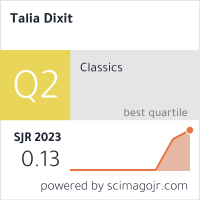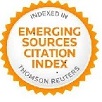La Tercera Sofística en el marco teórico de la historiografía sobre la Antigüedad Tardía y el Postmodernismo
Palabras clave:
Retórica, Antigüedad tardía, Tercera SofísticaResumen
Los estudios sobre la antigüedad tardía han provocado que crezca el interés por la literatura griega y latina de época imperial y, con ello, por la retórica tardo-antigua. Desde hace varias décadas se ha propuesto denominar como “Tercera Sofística” a las producciones retóricas de los siglos IV-VI. Al margen de la conveniencia de esta nueva clasificación, es llamativo que el sintagma “Tercera Sofística” haya sido aplicado para bautizar nuevos movimientos filosóficos, historiográficos y literarios. Este trabajo se propone estudiar, catalogar y describir las diferentes “Terceras Sofísticas” que han venido apareciendo en las últimas cuatro décadas
Descargas
Referencias
AGUILAR GIMÉNEZ, A. (2004), Retórica y post-estructuralismo. Introducción a la materialidad del lenguaje en teoría de la literatura, Tesis doctoral, Valencia.
ANDO, C. (2009), “Narrating decline and fall”, A Companion to Late Antiquity, Oxford: Wiley-Blackwell, pp. 59-76.
BALLIF, M. (1998), “Writing the Third-Sophistic Cyborg: Periphrasis on an [In]Tense Rhetoric”, Rhetoric Society Quarterly 28:4, 51-72.
BALLIF, M. y MORAN, M. G. (eds.) (2005), Classical Rhetorics and rhetoricians: critical studies and sources, Greenwood: Greenwood Press.
BARNES, T. D. (1971), Tertullian. A historical and literary study, Oxford: Oxford University Press.
BLOCH, M. (1975), “Why Oratory?”, Political language and oratory in traditional society, Londres: Academic Press.
BROWN, P. (1992), Power and Persuasion in Late Antiquity, Madison: University of Wisconsin Press.
BRUNT, P. A. (1994), “The Bubble of the Second Sophistic”, BICS 39, 25-52.
CAMERON, AL. (1999), “The last pagans of Rome”, The Transformations of Vrbs Roma in Late Antiquity, Portsmouth: Journal of Roman archaeology. Supplementary series 33, pp. 109-121.
CAMERON, AV. (2002), “The long Late Antiquity: a late twentieth-century model”, Classics in Progress. Essays on Anciete Greece and Rome, Oxford: University Press, pp. 165-191.
____ (2006) “New Themes and Styles in Greek Literature, A title revisited”, Greek Literature in Late Antiquity. Dynamism, Didacticism, Classicism, Harvard: Ashgate, pp. 11-27.
DUARTE, D. (2004), Electronic Writing Technologies and the Third Sophistic, Unpublished PhD, Texas.
EASTERLING, P. y HALL, E. (eds.) (2002), Greek and Roman Actors. Aspects of an Ancient Profession, Cambridge: Cambridge University Press.
ELSNER, J. (2002), “The birth of Late Antiquity: Riegl and Strzygowski in 1901”, Art History 25.3, 358-379.
FORBES, C. (1986), “Comparison, self-praise and irony: Paul ́s boasting and the conventions of Hellenistic rhetoric”, NTS 32, 1-30.
GILDENHARD, I. y RUELH, M. (eds.) (2003), Out of Arcadia. Classics and Politics in Germany in the Age of Burckhardt, Nietzsche and Wilamowitz, Londres: Institute of Classical Studies.
GLEASON, M. (1995), Makingmen. Sophists and self-presentation in Ancient Rome, Princeton: University Press.
GÜTHENKE, C (2009), “Shop Talk. Reception Studies and recent work in the history of scholarship”, Classical Receptions Journal 1:1, 104-115.
HOMES DUCEN, F. (1935), The life and time of St. Ambrose, Oxford: Clarendon Press.
KALDELLIS, A. (2007), Hellenism in Byzantium: The Transformations of Greek Identity and the Reception of the Classical Tradition, Cambridge: University Press.
KENNEDY, G. (2003), “Some recent controversies in the Study of Later Greek Rhetoric”, AJPh 124.2, 295-301.
KERFERD, G. B. (1981), “The future direction of Sophistic Studies”, The Sophists and their Legacy, Wiesbaden: Steiner.
LUGARESI, L. (2008), Il teatro di Dio : il problema degli spettacoli nel cristianesimo antico (II-IV secolo), Brescia: Morcelliana.
MACCORMACK, S. (1981), Art and Ceremony in Late Antiquity, Berkeley-Londres: University of California Press.
MALOSSE, P. L. y SCHOULER, B. (2009), “Qu ́est-ce que la troisieme sophistique”, Lalies 29, 161-224.
MARCHAND, S. (1996), Down from Olympus. Archaeology and Phillohelenism in Germany (1750-1970), Princeton: University Press.
MARCONE, A. (2008), “A Long Late Antiquity? Considerations on a Controversial Periodization”, Journal of Late Antiquity 1:1, 4-19.
MILAZZO, A. (2000), Un dialogo difficile: la retorica in conflitto nei Discorsi Platonici di Elio Aristide, Olms: Neuware.
MURPHY, J. J. (1974), Rhetoric in the Middle Ages. A History of Rhetorical Theory from Saint Augustine to the Renaissance, Londres-Berkeley: University of California Press.
PERNOT, L. (1993), La rhétorique de l ́éloge dans le monde Greco-Romainm París: Institut d ́études Augustinnienes.
____(1998), “La rhétorique de l ́Empire ou comment la rhétorique grecque a inventé l ́Empire romain”, Rhetorica 16: 2, 131-148.
____(2000) La rhétorique dans l ́Antiquité, París : Librairie Générale Française.
____(2006) “La Seconde Sophistique et l ́Antiquité Tardive”, Classica 19:1, 30-44.
POULAKOS, J. (1990), “Interpreting Sophistical Rhetoric: a response to Schiappa”, Rhetoric and Philosophy 23:4, 218-228.
____(2007), “Modern Interpretations of Classical Greek Rhetoric”, ACompanion to Greek Rhetoric, Oxford: Blackwell, pp. 16-26.
PUECH, B. (2002), Orateurs et sophistes grecs dans les inscriptions d ́époque impériale, París: Librairie Philosophique.
REARDON, B. P. (1971), Courants litteraires grecs des II et III siécles après J.-C., París: Les Belles Lettres.
SAID, E. (1978), Orientalism, Nueva York: Pantheon.
SCHAMP, J. (2006), Sophistes à l ́ambon. Esquisses pour la Troisième Sophistique comme paysage littéraire, en Approches de la Troisième Sophistique. Hommage à Jaques Schamp, Bruselas: Coll. Latomus, pp. 286-338.
SCHIAPPA, E. (1990) “”Neo-Sophistic Rhetorical Criticism or the Historical Reconstruction of Sophistic Doctrines?”, Rhetoric and Philosophy 23:3, 192-217.
SCHOULER, B. (1977), La tradition hellenique chez Libanios, Lille : Les Belles Lettres.
VITANZA, V. (1991), “Some more notes, toward a Third Sophistic”, Argumentation 5, 117-139.
WARD-PERKINS, B. (2007), La caída de Roma y el fin de la civilización, Madrid: Espasa.
WATTS, E. J. (2006), City and School in Late Antique Athens and Alexandria, Berkeley: University of California Press.
WENDLAND, E. R. (2002), “Aspects of Rhetorical Analysis applied to New Testament texts”, Handbook of Early Christianity. Social Science Approaches, Boston-Oxford: Altamira Press, pp. 169-195.
WHITMARSH, T. (2005), The Second Sophistic, Oxford: University Press.
WINTER, B. (1997), Philo and Paul among the Sophists, Cambridge: Eerdmans












